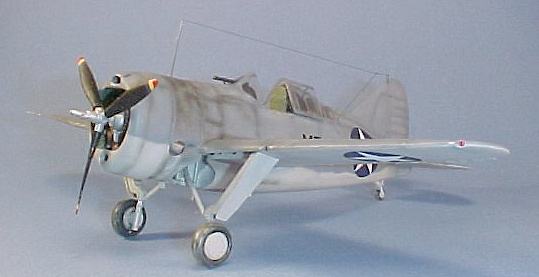
|
KIT: |
Tamiya 1/48 F2A-3 Buffalo |
|
KIT # |
61031 |
|
PRICE: |
$26.00 |
|
DECALS: |
See review |
|
REVIEWER: |
|
|
NOTES: |
Mild conversion |

|
HISTORY |
How the Brewster Aeronautical Corporation, a company that had been well-known throughout the 19th century as a buggy-maker became an airplane company in the early 1930s is one of those wonders of American capitalism known only to the participants. Nevertheless, by 1932, the company was engaged in subcontracting aeronautical parts at its factory on Long Island when they decided to hire Dayton T. Brown as Chief Designer and concentrate their efforts on the carrier-based aircraft market for the U.S. Navy. The first product of this effort was the SBA-1, an advanced all-metal monoplane divebomber which was contracted for in 1934 and first flew in 1936; the design was purchased by the Navy and produced as the SBN-1 at the Naval Aircraft Factory in Philadelphia. This was due to the fact the Navy did not believe Brewster was capable of organizing production of an aircraft, though they could obviously design one.
In late 1935, the Navy opened bids for a carrier fighter to replace the Grumman F3F series. The success of the SBA-1 had given Dayton Brown credibility with the Bureau of Aeronautics that was sufficient to result in his XF2A-1 being selected as the Navy's first monoplane fighter. The XF2A-1 first flew on December 2, 1937. Official tests in early 1938 revealed a need for more detailed aerodynamic development; tests of the modified prototype revealed a top speed of 304 mph, an initial climb of 2,750 fpm and a range of 1,000 miles. The 54 F2A-1s produced were essentially this airplane. In 1939, Brewster reworked the prototype, installing a 1,200 hp engine, redesigning the cowl and shortening the fuselage; the result was the XF2A-2, with a top speed of 340 mph, and a range of 1,600 miles - considerably more than most other fighters with the exception of the airplane that would become the F2A's primary opponent, the Zero. Many pilots who were experienced with the F2A-2 later stated that if this had been the version that went to war in the Pacific in 1942, with better-trained pilots, that the judgement of history on the design would have been far different since they saw it as superior to the F4F-3 Wildcat.
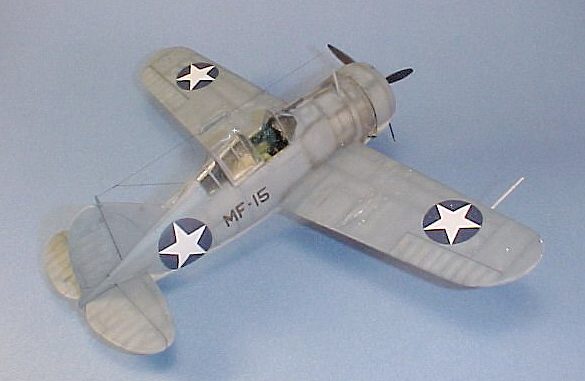 The F2A-2 was
essentially the airplane flown by the British and Dutch air forces in the far
east at the commencement of the Pacific War. While at least two Commonwealth
pilots became aces over Singapore in the Buffalo, the airplane's reputation was
mauled by the lighter, more maneuverable Japanese fighters. Had the Allied
pilots had more than a few months to get used to their Buffalos, and had proper
tactics been used to take advantage of the airplane's strong points, the record
might have been different, though the overwhelming odds would likely have
produced the same end result.
The F2A-2 was
essentially the airplane flown by the British and Dutch air forces in the far
east at the commencement of the Pacific War. While at least two Commonwealth
pilots became aces over Singapore in the Buffalo, the airplane's reputation was
mauled by the lighter, more maneuverable Japanese fighters. Had the Allied
pilots had more than a few months to get used to their Buffalos, and had proper
tactics been used to take advantage of the airplane's strong points, the record
might have been different, though the overwhelming odds would likely have
produced the same end result.
In January 1941, the Navy 108 F2A-3 Buffalos, the final order for the airplane. Difficulties in sealing the wing fuel tanks and the seeming never-ending problems with the landing gear (though it was later discovered that increasing tire pressure solved the problem) - coupled with Brewster's inability to deliver aircraft on schedule because of its poor management and impossible production facility (the airframes were carted up and down between three floors during the course of construction, then had to be disassembled and trucked to an airfield where they were reassembled for flight testing) and the bad reputation the company's sales team was developing - had soured the Navy on the F2A for political reasons.
Fuel capacity of the F2A-3 was increased to 240 gallons, resulting in a ten-inch increase in fuselage length and later CG problems, while armor and ammunition capacity was raised to 1941 combat standards - all with no increase in engine power; gross weight of the F2A-3 at 6,518 lbs was 1,400 lbs heavier than the F2A-1. Maximum speed decreased to 321 mph, rate of climb and service ceiling also deteriorated. The increased fuel gave the airplane a range of 1,680 miles. VF-2 pilots later reported flying 5-6 hour combat air patrols; the Navy had originally planned to use the F2A-3 as a long-range fleet defense fighter, though the advent of radar made this unnecessary.
The Buffalo at Midway:
By May 1942, no U.S. Navy fighter squadron was using the F2A, and the surviving F2A-2s were already being sent to NAS Miami to become advanced trainers. The Marines equipped two squadrons - VMF-211 Palmyra Island, and VMF-221 on Midway. VMF-221 scored the first victory for an American Buffalo on March 10, 1942, when a flight of four aircraft led by Capt. J. Neefus found a pre-production H8K "Emily" near Midway. In the ensuing fight with the heavily-armed flying boat, one F2A-3 was damaged before the others shot down the "Emily."
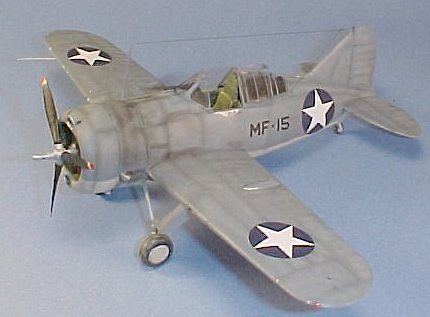 On June 4, 1942,
VMF-221 had 21 F2A-3s and seven F4F-3 Wildcats, under the command of Major Floyd
B. Parks. When 25 airplanes (20 F2A-3s and 5 F4F-3s) intercepted the Japanese
strike, 13 F2As and 2 F4Fs were shot down by the defending Zeros. During the
fight, Capt. William C. Humberd dove away from his pursuers and engaged a Zero
from "Akagi" in a head-on fight low over the water, during which the Zero was
shot down. Humberd was later awarded the Navy Cross for this action.
On June 4, 1942,
VMF-221 had 21 F2A-3s and seven F4F-3 Wildcats, under the command of Major Floyd
B. Parks. When 25 airplanes (20 F2A-3s and 5 F4F-3s) intercepted the Japanese
strike, 13 F2As and 2 F4Fs were shot down by the defending Zeros. During the
fight, Capt. William C. Humberd dove away from his pursuers and engaged a Zero
from "Akagi" in a head-on fight low over the water, during which the Zero was
shot down. Humberd was later awarded the Navy Cross for this action.
Sixty percent losses are hard to take, but in the defense of the F2A-3 itself, one must consider that 8 of the pilots were fresh from flight school and had only joined the squadron on May 26, nine days before the battle. Their opponents were seasoned veterans of the most effective naval air arm in the world, flying what was at the time the finest carrier-based fighter in the world. Against these American losses, the Japanese admitted the destruction of seven B5N2 "Kates" and two A6M-2 "Zeros."
In 1992, I had the opportunity to speak with the late MGEN Marion Carl, who had flown one of the VMF-221 Wildcats at Midway, during which he scored his first victory. Later a famous ace in the bloody struggle for Guadalcanal, General Carl startled me by saying that - had the Marines at Midway had the understanding of proper tactics against the Japanese that he and others used over Guadalcanal - the outcome might have been far different. He went on to say that the difference between the F2A-3 Buffalo and the F4F-4 Wildcat performance-wise was not so much that if he had flown the F2A-3 at Guadalcanal using proper tactics, he believed he would have scored as he did in the Wildcat.
General Carl's theory is not wrong when one considers that between June 1941 and September 1944, Finnish pilots equipped with 44 F2A-1 Buffalos shot down 496 Soviet aircraft for a combat loss of 19 Buffalos, a victory-loss ratio of 26:1 - better than almost any other fighter flown by any other air force in the war. The Finnish pilots were well-trained and experienced, and flying an airplane 1,400 pounds lighter than that which the inexperienced Marines used at Midway.
|
THE KIT |
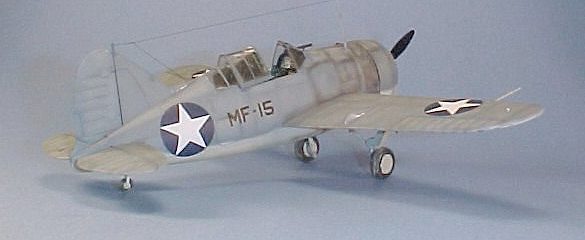 It is hard to believe
that the Tamiya Buffalo first saw the light of day 27 years ago. I well
remember the furor the kit produced, when it was released at a retail price of
about $10, at a time when the average price of a kit was under $2. It was one
of the first plastic models to feature a detailed cockpit (to this day and using
contemporary standards, you can build a very acceptable model using nothing but
what is provided in the kit). I think that the Buffalo, along with the Zero
series Tamiya released around the same time, were the first of what became the
"super kits" we are all familiar with today. Both the Buffalos and the Zeros
stand up well in comparison to later Zero kits, and there has been no
replacement of the Buffalo. In its original form, the kit provided two
different cockpit canopies - one for a US Navy F2A-2 and one for a 339-series
export fighter as used by the British and Dutch, two different tail cones and
tail wheels to cater to the physical differences between the two, and an armor
back plate for the export version. In its most recent re-release, Tamiya has
seen fit to release it only as an F2A-2, with the Navy canopy and tail cone.
I've done both the Navy and RAF versions,
and used only a Squadron vacuformed canopy to improve the kit over what is
originally provided.
It is hard to believe
that the Tamiya Buffalo first saw the light of day 27 years ago. I well
remember the furor the kit produced, when it was released at a retail price of
about $10, at a time when the average price of a kit was under $2. It was one
of the first plastic models to feature a detailed cockpit (to this day and using
contemporary standards, you can build a very acceptable model using nothing but
what is provided in the kit). I think that the Buffalo, along with the Zero
series Tamiya released around the same time, were the first of what became the
"super kits" we are all familiar with today. Both the Buffalos and the Zeros
stand up well in comparison to later Zero kits, and there has been no
replacement of the Buffalo. In its original form, the kit provided two
different cockpit canopies - one for a US Navy F2A-2 and one for a 339-series
export fighter as used by the British and Dutch, two different tail cones and
tail wheels to cater to the physical differences between the two, and an armor
back plate for the export version. In its most recent re-release, Tamiya has
seen fit to release it only as an F2A-2, with the Navy canopy and tail cone.
I've done both the Navy and RAF versions,
and used only a Squadron vacuformed canopy to improve the kit over what is
originally provided.
|
CONSTRUCTION |
Converting the F2A-2 to and F2A-3:
There was at one time a resin conversion set for the F2A-3 released by Aeromaster about 8-9 years ago, but in truth the necessary work to turn the kit into an F2A-3 is so simple that all you need is some Evergreen sheet plastic, some putty and glue, and a minor modicum of modeling ability to create the last Buffalo. The big thing is to increase the fuselage length by ten inches between the leading edge of the wing and the rear edge of the engine cowling. The other visual difference is that the sliding canopy of the F2A-3 did not have the metal stiffeners in it that the F2A-1 and -2 did - though the canopy was still assembled in pieces, so the scribing is still necessary though it is not painted.
Ten inches in 1/48 comes out to a bit less than 1/4 inch; in my case, I settled on 7/32 of an inch, since I had a ruler with that measurement, so I could cut the Evergreen sheet that wide. I used a sheet of 1/16" sheet, since that was close to the thickness of the fuselage, so that I could reinforce the plug internally with thinner Evergreen sheet glued over the joint.
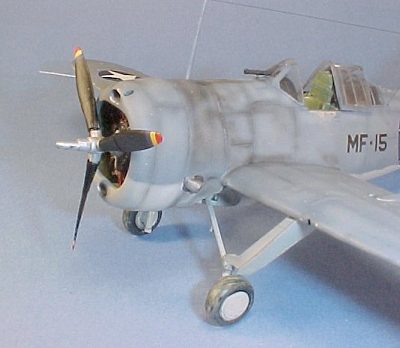 Next, take out your
trusty razor saw, and section the fuselage. There is a panel line about 1/8
inch to the rear of the cowling, and I used this as my guide. I cut the parts
before assembly of the fuselage, so that I could perform the internal
stiffening. The piece of Evergreen sheet was curved and bent to approximate the
curvature of the fuselage as closely as possible, then glued in position and the
cowling glued back on. The thin sheet was glued inside and everything was left
to set up. I did the same with the lower fuselage section of the lower wing
part. At this point, the conversion was essentially completed.
Next, take out your
trusty razor saw, and section the fuselage. There is a panel line about 1/8
inch to the rear of the cowling, and I used this as my guide. I cut the parts
before assembly of the fuselage, so that I could perform the internal
stiffening. The piece of Evergreen sheet was curved and bent to approximate the
curvature of the fuselage as closely as possible, then glued in position and the
cowling glued back on. The thin sheet was glued inside and everything was left
to set up. I did the same with the lower fuselage section of the lower wing
part. At this point, the conversion was essentially completed.
I proceeded to assemble the rest of the model per the kit instructions, after painting the cockpit interior in interior green. I am not absolutely certain of this, but the F2A-3 appeared at the time the Navy was going from cockpits painted with aluminum lacquer to cockpits in interior green, and decided Brewster would have gone along with the crowd, inasmuch as the F2A-3s weren't delivered until the fall of 1941.
Once everything was glued together, I puttied over the Evergreen strip in the nose, and sanded it smooth when dry. I then used Mr. Surfacer on all the other joints, sanded everything smooth, and rescribed the panel lines in the nose according to the profile drawings in the Squadron "F2A Buffalo In Action."
I didn't have access to a Squadron vacuform canopy at the time I did this, but since I was using an older kit purchased at a swap meet in a bag for $10, I had both canopies. I cut open the RAF canopy and saw I could make this fit with a bit of fiddling, so decided I would do at that way with the US Navy canopy (trust me kids, there was a time back in the age of dinosaurs when all "open canopies" were done this way if you didn't have access to a Mattel vacuformer - and we had to walk five miles uphill through a blizzard in both directions to accomplish this work). I Futured the windshield and the aft canopy, glued them to the model and masked them for painting.
|
PAINT & DECALS |
Painting:
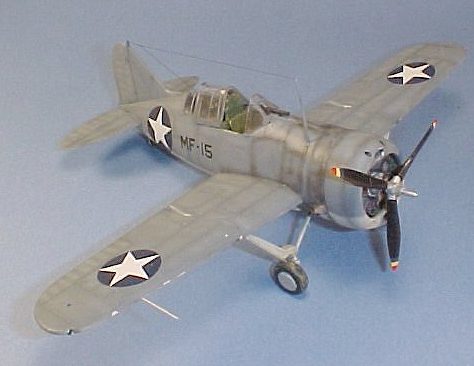 I used Gunze-Sanyo H-42
Blue-Grey Gloss and Gunze-Sanyo H-51 Light Gull Grey for the upper and lower
camouflage. In this case, since I was doing an airplane that had been exposed
to the elements at a base near the equator for several months, I started by
lightening the Blue-Grey with some of the Light Gull Grey to start with, then
lightened it with more Light Gull Grey as I went back and "faded" the upper
scheme. When it was done I Futured the model.
I used Gunze-Sanyo H-42
Blue-Grey Gloss and Gunze-Sanyo H-51 Light Gull Grey for the upper and lower
camouflage. In this case, since I was doing an airplane that had been exposed
to the elements at a base near the equator for several months, I started by
lightening the Blue-Grey with some of the Light Gull Grey to start with, then
lightened it with more Light Gull Grey as I went back and "faded" the upper
scheme. When it was done I Futured the model.
Decals:
The decals came out of the spares box, with the "MF-15" coming from an Accurate Miniatures F3F sheet. After washing off the decal setting residue and then Futuring again, it was time for the final finish painting.
Final Finish Painting and Weathering:
The dark stains aft of the engine on this model are not "heavy pre-shading," they are oil stains. I was doing the airplane flown by Captain Humberd, which is the subject of the cover art of the Squadron book, which shows the heavy staining. Additionally, a photograph of this same airplane when it was used at NAS Miami shows even more staining. I also did exhaust staining on the lower fuselage. This was all done with thinned Tamiya "Smoke." Other than that, I "dinged" the airplane on the leading edges of the flying surfaces, the upper wings, etc., with Testor's Model Master Aluminum. I finished off with several coats of thinned Testor's Dullcote lacquer to give the flat finish the model now has.
|
CONCLUSIONS |
Scratch conversions are fun, and this one is so simple that anyone with the hand-eye coordination to operate their computer to get here and read this article has the dexterity to do it themselves. It would in fact be a good first conversion project for anyone. While the kit canopy is just fine, I suspect if I run across a Squadron vacuform canopy in the future, I will replace what's here with that, but I am not going to be looking all that hard for one.
My little line-up of Buffalos - Navy F2A-1, Finnish B-239, Navy F2A-2, British B-339 - looks much better now with this F2A-3 finishing off the collection. 27 years later, the Tamiya Buffalo has no need of hiding from the competition of any later super-model.
July 2002
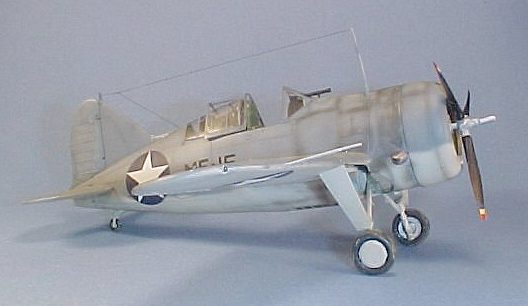
Kit courtesy of my thinning wallet.on.
If you would like your product reviewed fairly and quickly where it will be seen by well over 150,000 visitors a month, please contact me or see other details in the Note to Contributors.